Welcome to our Colossus Movie Guide for The Human Condition I: No Greater Lover. This guide contains everything you need to understand the film. Dive into our detailed library of content, covering key aspects of the movie. We encourage your comments to help us create the best possible guide. Thank you!
What is The Human Condition I: No Greater Love about?
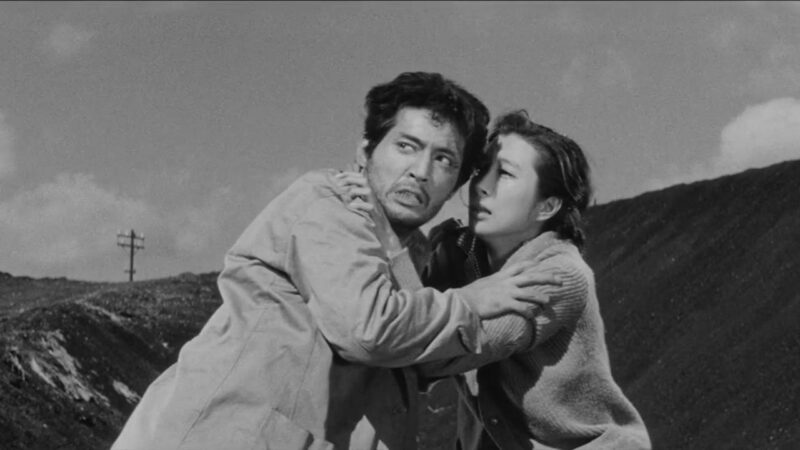
The Human Condition I: No Greater Love (Ningen no joken I: Koreijō no ai wanai) is a deep exploration into the stark realities of war, the human spirit, and the perpetual struggle between idealism and pragmatism. Set against the backdrop of World War II and based on Junpei Gomikawa’s six-volume novel, the epic unravels the complex fabric of human morality, identity, and dignity. Through the trials of the protagonist Kaji (played fantastically by Tokyo-born actor Tatsuya Nakadai), the film probes profound questions about humanity’s capacity for compassion and cruelty in dire circumstances.
At its core, No Greater Love grapples with themes of existentialism, moral ambiguity, and the ruthless mechanics of oppressive systems. The protagonist’s struggle, while rooted in a specific historical context, symbolizes the universal human quest for meaning and justice amidst systemic corruption and inhumanity. The film, a raw indictment of its nation, sharply criticizes the brutalities of war and the inherent flaws within bureaucratic systems, illustrating the destructive consequences on individual lives and spirits. It is a chilling examination of the human condition, underlining the paradox of existence in a world stricken with war and strife.
Movie Guide table of contents
Cast
- Tatsuya Nakadai – Kaji
- Michiyo Aratama – Michiko
- Chikage Awashima – Tōfuku Kin
- Ineko Arima – Shunran Yō
- Sō Yamamura – Okishima
- Keiji Sada – Kageyama
- Kōji Nanbara – Kao (as Shinji Nanbara)
- Akira Ishihama – Chen
- Kōji Mitsui – Furuya
- Seiji Miyaguchi – Wang Heng Li
- Eitaro Ozawa – Okazaki
- Toru Abe – Sergeant Watai
- Junkichi Orimoto – Sai
- Masao Mishima – Manager Kuroki
- Kyū Sazanka – Cho Meisan
- Zenzo Matsuyama – Writer
- Masaki Kobayashi – Writer and director
Why is the movie called The Human Condition I: No Greater Love?
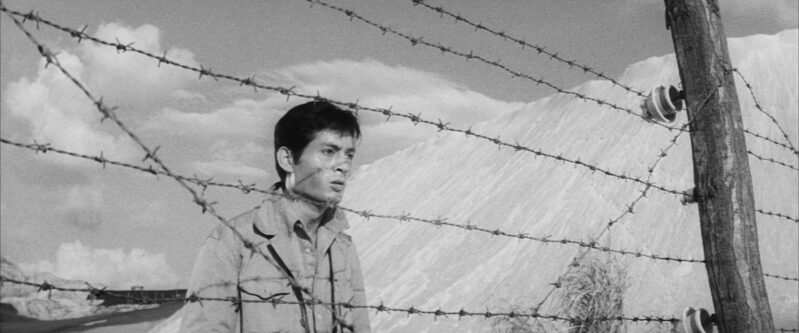
The title of the film, The Human Condition I: No Greater Love, is a profound and multilayered piece of Japanese cinema, embodying a deep exploration of the human spirit (a key theme in the film) amidst the turmoil of war and systemic oppression. It provides a thematic lens through which the audience can comprehend the complexities of the narrative and the character arcs within the film.
The “No Greater Love” segment of the title (the film is the first in a trilogy, which includes Road to Eternity and A Soldier’s Prayer) is a phrase that invokes religious undertones, echoing the biblical verse John 15:13, “Greater love has no one than this: to lay down one’s life for one’s friends.” In the context of the film, this phrase becomes symbolic of Kaji’s self-sacrificing nature, his immense capacity for empathy, and his unwavering commitment to his principles, even in the face of immense adversity. Kaji, working within the confines of a POW camp, strives to uphold his ideals of fairness and humanity, to love others in the sense of respecting their dignity and worth, even when it means risking his own life.
The phrase “No Greater Love” also invites the audience to question the nature of love itself. The film, a classic of novelistic cinema, argues that the greatest form of love might not be romantic or familial, but rather the love that extends compassion and dignity to all of humanity, even in the direst of circumstances. It is the love that inspires self-sacrifice, the love that provokes individuals to fight against injustice, and the love that refuses to be extinguished, even amidst the cruelty of war.
Simultaneously, the title’s initial part, “The Human Condition,” prepares the audience for an exploration into the core aspects of human existence. It suggests that the film will delve into the innate aspects of humanity, the universal experiences that connect us across different cultures and epochs. The human condition, in this context, refers to the struggles, moral dilemmas, triumphs, and tragedies that define the human experience.
In combination, “The Human Condition I: No Greater Love” signals a story that reflects the human capacity for courage, empathy, and resilience against brutal, dehumanizing circumstances. It points to the exploration of love as a transformative force, one capable of challenging oppressive systems and illuminating the darkest corners of the human experience. It suggests a narrative that won’t shy away from depicting the ugly truths of war and oppression, yet remains steadfast in its belief in the redeeming power of love and humanity. Through this lens, this mammoth humanist drama scrutinizes the paradoxes of the human condition, the coexistence of the capacity for immense cruelty and boundless love within individuals and societies. Thus, the title itself serves as an encapsulation of the film’s central themes and its profound exploration of human existence.
The themes and meaning of The Human Condition I: No Greater Love
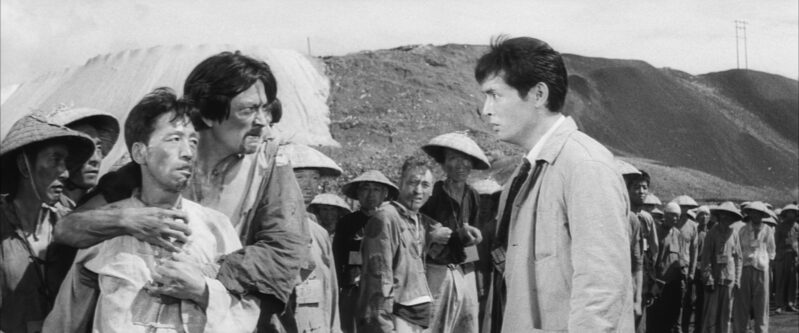
Self-actualization: achieving your full potential
Abraham Maslow’s hierarchy of needs (a concept discussed in our Being John Malkovich explanation) is a psychological theory that posits a five-tier model of human needs, depicted as hierarchical levels within a pyramid. From the bottom of the hierarchy upwards, the needs are: physiological, safety, love and belonging, esteem, and self-actualization. The theory suggests that to reach the upper level needs, the needs at the lower levels must be satisfied. The “human condition” encapsulates the totality of the human experience, which can be mapped onto Maslow’s hierarchy.
The Human Condition I: No Greater Love resonates with this theory, illustrating how war and systemic oppression threaten the fulfillment of these basic human needs, while simultaneously depicting the profound struggle to satisfy them. The characters grapple with the most fundamental physiological needs—hunger, thirst, and survival in the POW camps—before moving to their safety needs, which are continuously threatened by war and inhumane working conditions.
The film also delves into the needs for love and belonging, and esteem, as Kaji yearns for companionship, respect, and dignity amidst the harsh realities of war. His relationship with his wife Michiko, his friendships, and even his interactions with the prisoners underscore the human yearning for connection, love, and mutual respect.
However, the pinnacle of Maslow’s hierarchy—self-actualization—echoes most deeply with the film’s exploration of the “human condition.” Self-actualization refers to the realization of one’s full potential, a need which Kaji embodies throughout the film. Despite the atrocities around him, he persistently upholds his moral principles and continues to fight against injustice, showing a steadfast commitment to fulfilling his potential as a moral, compassionate being.
The film’s title, No Greater Love, can also be seen in relation to this idea of self-actualization. Kaji’s actions reflect a deep sense of love—not just a romantic or familial love, but a broader, more profound love for humanity. This exemplifies the highest form of self-actualization, demonstrating an unyielding adherence to one’s values and ideals, even when confronted with the harshest realities of the human condition.
The omnipresence of war
The theme of the horrors of war in The Human Condition I: No Greater Love permeates more than just the physical battlefield. It is an omnipresent entity, affecting every aspect of society, not merely through direct combat but also through its profound societal and psychological impacts.
Kaji’s journey epitomizes this theme. Despite his initial exemption from military service, he is thrust into a role that brings him face to face with the atrocities of war. His position in the POW labor camp, though removed from the front lines in the middle of the desert (an important motif in the film), offers no escape from the cruelty and inhumanity that are symptomatic of war.
This omnipresence of war is akin to a malignant force that metastasizes through the fabric of society, influencing the way people behave, relate to one another, and perceive their world. Individuals are stripped of their humanity, moral principles are compromised, and societies are reshaped in ways that amplify the stark brutality and profound tragedy of war.
In highlighting this pervasive influence of war, the film also provokes its audience to grapple with questions regarding resistance and survival within such conditions. The antidote to this widespread horror, as depicted in the film, is perhaps found in the steadfastness of one’s moral principles and the resilience of the human spirit.
The seemingly naive Kaji’s persistent adherence to his ideals of justice, compassion, and humanity, even in the face of tremendous adversity, signifies an antidote to the corrosive effects of war. He navigates the horrors around him by continually asserting his humaneness, resisting the degradation of his principles and of those around him. His actions suggest that while war may be omnipresent, so too is the capacity for human resilience, dignity, and moral integrity, offering a glimmer of hope amidst the atrocities.
The enduring human spirit
The theme of the resilience of the human spirit is integral to The Human Condition I: No Greater Love. Despite the bleak circumstances that Kaji finds himself in, his resilience and his unyielding adherence to his moral principles serve as an embodiment of the enduring human spirit. Even though he is beaten and forced to go to war, his spirit remains unbroken. Ultimately, his humanism and morals serve as an impediment to a quiet, fulfilling life with his wife.
While the film could be interpreted as director Masaki Kobayashi’s pessimism (he also directed the tragic film Harakiri), it could also be seen as a realistic depiction of the harsh circumstances of war and an exploration of the human capacity to endure in the face of profound adversity. This portrayal does not diminish Kaji’s actions. Instead, it highlights the value of moral courage and the importance of maintaining one’s principles, even in the face of apparent defeat.
Kaji’s character becomes a beacon of hope and an embodiment of resilience for the audience. His actions, despite the harsh consequences, illustrate that courage and moral integrity can persist even in the face of extreme adversity. His actions do not merely reflect his character but serve as an enduring testament to the human capacity for resilience, courage, and endurance.
In a sense, this personal existential tragedy serves as a meta-narrative, with Kaji’s resilience serving as an eternal testament to the human spirit’s capacity to resist, endure, and assert its dignity. His story continues to inspire, motivate, and resonate with audiences, extending the narrative beyond the confines of the film. His fight may have been lost, but his spirit continues to inspire resistance against oppression and war, asserting that the pursuit of peace and justice is an ongoing journey, one that is never truly over.
The ending of The Human Condition I: No Greater Love explained
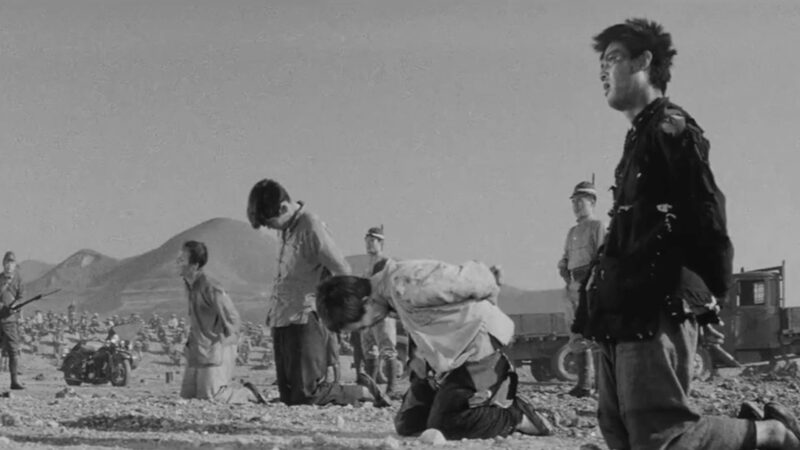
The Human Condition I: No Greater Love endures as a cinematic masterpiece that delves into the intricate labyrinth of war and the indomitable spirit of humanity. The climax of the film unearths profound reflections on the nature of power, injustice, and the capacity of one individual to make a stand against systemic brutality.
A recap of No Greater Love’s ending
As The Human Condition I: No Greater Love reaches its climax, Kaji finds himself caught in a sequence of increasingly horrific events. The first of these is when he is forced to serve as a witness to the execution of several Chinese prisoners. In a chilling scene, we watch Kaji grapple with his own impotence in the face of such brutality, his every expression reflecting his internal struggle.
In the ensuing chaos, Kaji stands up to Sergeant Watai. As a result, Watai steps forward with his blade to strike Kaji, but Kaji refuses to move. Inspired by his actions, the Chinese POWs start chanting “murderers!” and don’t back down when Watai’s soldiers point their guns. Fearing a revolt, Watai decides to call off the execution.
In the aftermath of these events, Kaji is falsely accused of being a Red sympathizer and is arrested. He is then subjected to Watai’s abuse and torture, where despite his pleas of innocence and desperate attempts to reason with his accusers, he is continually beaten. In the end, however, he is let go and relieved of his duties as labor camp supervisor at the large mining operation in Japanese-colonized Manchuria.
But it comes at a cost: he is sentenced to enlistment in the Imperial Japanese Army. The final moments of the movie capture the devastating irony of Kaji’s situation: his quest for peace and fairness ultimately lands him right in the midst of the very war he has so desperately sought to avoid.
The unfolding tragedy
As Kaji is forced to bear witness to the impending execution of several Chinese prisoners, the profound horror of his predicament becomes achingly clear. The juxtaposition of Kaji’s inherent morality against the merciless violence of war confronts the audience with the uncomfortable reality of human savagery. Despite the overwhelming odds, Kaji remains resolute. His audacious defiance of Sergeant Watai symbolizes his refusal to be subjugated by the dehumanizing influence of war.
Kaji’s revolt not only exemplifies personal courage but also galvanizes collective resistance. The chanting of the Chinese POWs epitomizes the strength of shared human sentiment against injustice, catalyzed by Kaji’s unwavering determination. The power dynamics shift momentarily, illustrating that even within systemic oppression, human dignity can catalyze transformative change.
However, Kaji’s moral victory comes at an excruciating price: accusations of red sympathy, relentless torture, and a final sentencing to the Imperial Japanese Army. His fate accentuates the profound irony of his journey—his fight for peace thrusts him directly into the heart of war.
The legacy of Kaji’s struggle
Despite the bleak conclusion of Kaji’s journey, his character represents a beacon of hope and resilience. Even under immense pressure and in the face of extreme adversity, Kaji never compromises his principles. His relentless pursuit of justice and fairness, regardless of the personal cost, paints a portrait of an individual who is willing to sacrifice everything for the betterment of humanity.
The potency of Kaji’s story is magnified when viewed through the lens of Hannah Arendt’s analysis of the human condition. Arendt identifies three core components of the human condition: labor, work, and action. Kaji’s relentless efforts to improve conditions for the Chinese prisoners (labor), his constructive attempts to cultivate a sense of justice within the mining camp (work), and his decisive stand against the atrocities of war (action) resonate strongly with Arendt’s paradigm.
In Arendt’s perspective, the capability for action, in particular, signifies the potential to initiate sequences of events, which can significantly alter the world. Kaji’s insubordinate action against Watai and the subsequent stirrings of rebellion among the POWs exemplify this. His actions become a catalyst for change within his sphere of influence, despite the seemingly insurmountable odds.
A timeless inspiration
Arendt also posits the concept of the “public realm,” where individuals can manifest their distinct identities through actions and words. Kaji’s refusal to be silent, his determination to act against injustice, and his willingness to bear the consequences of such decisions mark his distinct identity in the narrative.
Even as he is dragged into the vortex of war, Kaji’s spirit remains unbroken. The concluding moments of the film emphasize the relentless spirit of humanity that persists against adversities. Kaji’s journey reflects the broader struggle for justice, dignity, and peace, mirroring the battles fought by countless individuals against systemic oppression throughout history.
In the face of systemic violence and dehumanization, Kaji becomes a symbol of defiance, resilience, and, ultimately, the enduring power of the human spirit. His story becomes a beacon of hope, encouraging the viewers to resist and stand against the tide of injustice and oppression. Despite the tragedy of his fate, his legacy echoes through time, inspiring generations to strive for justice and peace.
The enduring legacy of The Human Condition I: No Greater Love lies in its exploration of the profound resilience of the human spirit in the face of seemingly insurmountable adversities. The concluding moments of the film, while heartbreaking, shine with the irreplaceable light of human courage, perseverance, and hope. It is a testament to the relentless quest for justice, even in the darkest corners of human existence, and it is this enduring quality that makes the film’s ending and Kaji’s journey a timeless source of inspiration.
Important motifs in The Human Condition I: No Greater Love
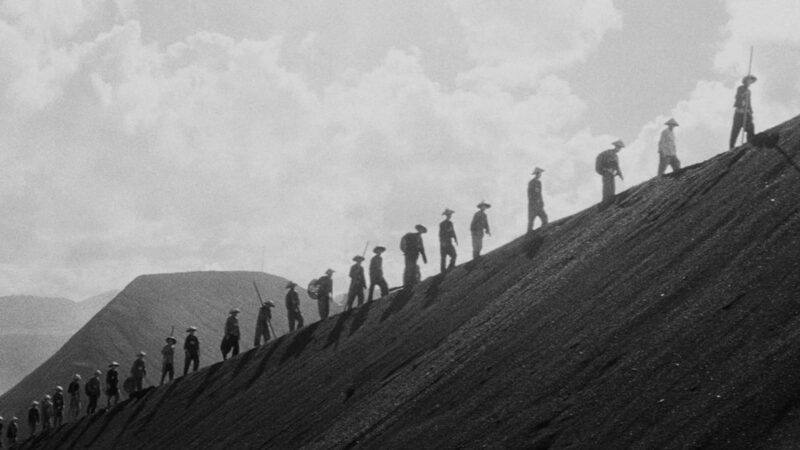
The desert
The desert in The Human Condition I: No Greater Love is a stark and powerful motif, embodying a multitude of symbolic meanings. Its vastness, desolation, and hostility mirror the oppressive and dehumanizing atmosphere of war.
The barren landscape of the desert is a constant reminder of the harsh reality that Kaji and others face. It echoes the bleakness of their existence within the mining camp, where life has been reduced to mere survival. The desert, therefore, mirrors the desolation of their human condition—stripped of dignity, freedom, and often hope.
Simultaneously, the desert serves as a metaphorical battlefield. Just as soldiers in war must navigate the treacherous terrain, Kaji must traverse the challenging environment of the mining camp. He must endure, resist, and ultimately survive the harsh conditions imposed upon him by the war machinery.
The desert can also be viewed as a symbol of isolation and loneliness. Its vast, empty expanse reflects the emotional distance between Kaji and the world outside the camp. Despite his persistent efforts, Kaji is often left feeling misunderstood and alone, much like a lone wanderer in a vast desert.
However, despite its hostile nature, the desert is also a place of profound transformation. It is in this challenging terrain that Kaji’s character is truly tested and honed. His struggles against the oppressive forces of the mining camp, like a journey through a desert, strengthen his resilience and determination, ultimately shaping his unyielding spirit.
The mine
The mining complex in The Human Condition I: No Greater Love stands as a powerful motif, serving to reflect the oppressive systems that dehumanize and degrade individuals. More than a mere location, the mine assumes a character of its own, painting a bleak picture of human existence under harsh conditions.
The mine symbolizes an infernal, hellish world, a corrupt system where workers are reduced to expendable units of labor. This harsh environment embodies the brutal mechanization of human life under totalitarian systems. The men, just like the ore, are mined from the earth, ground down and used until they have nothing left to give. They are treated as commodities rather than individuals, echoing the greater war machinery that regards soldiers as expendable entities.
The inhuman conditions within the mine mirror the moral darkness prevalent in the world outside. It represents a microcosm of the external world, revealing the pervasive nature of war, oppression, and exploitation. The mine’s oppressive, brutal reality is a metaphor for the global wartime experience, underlining how these structures of power devalue human life.
Additionally, the mine underlines the theme of struggle and endurance, reflecting Kaji’s constant fight against the inhuman conditions that surround him. It is in this harsh environment that Kaji’s resilience and humanitarian principles are tested to their limits. He attempts to bring about change and inject humanity into this brutal environment, making the mine also a battleground for ideological conflict.
Sex
Sex plays a prominent role in The Human Condition I: No Greater Love, acting as a poignant motif that mirrors the dehumanization, abuse, and societal collapse that pervades the narrative. It is presented both in its absence, as seen in Kaji’s relationship with his wife, Michiko, and in its perverse and forceful implementation involving Chinese women and prisoners.
Chinese women are captured and forced into sexual servitude to Chinese prisoners, a harrowing instance of sexual exploitation and a bleak testament to the power dynamics within war. The women, already victimized by the war, are further reduced to commodities, their bodies made the battlefield of a different kind of violence. The degradation and dehumanization of these women are stark illustrations of war’s capacity to distort and exploit human relationships, further emphasizing the inhumanity of the circumstances.
Contrasting this is Kaji’s relationship with Michiko, characterized by a lack of a sexual relationship. This absence of sexual intimacy between Kaji and Michiko is emblematic of the personal sacrifices made in the face of a war-ravaged society. Despite their love for each other, their relationship exists within a context of stress, anxiety, and the constant threat of Kaji’s conscription, which shadows their interactions and puts a strain on their physical relationship. The toll of their harsh environment is thus communicated through the lens of their unfulfilled sexual relationship.
Abuse
Abuse forms an integral motif in The Human Condition I: No Greater Love, acting as a stark manifestation of the power dynamics and the dehumanizing effects of war and totalitarianism. This motif is showcased through physical, psychological, and systemic abuse that characters endure throughout the film.
Physical abuse is rampant within the mine and the army barracks, indicative of a harsh, authoritarian environment where brutality is used as a method of control. Kaji himself is subjected to brutal beatings and torture. This abuse is not only physical, but symbolic, highlighting the abusers’ dominance and their victims’ helplessness. Moreover, it signals the violent suppression of any form of resistance or dissent.
Psychological abuse, on the other hand, is often subtler but equally damaging. Characters live in a constant state of fear, anxiety, and humiliation, generated by the oppressive regime. The unending mental stress is as crippling as any physical torment, leading to despair and a sense of utter powerlessness. This psychological abuse is evident in the fear-induced silence of the workers and their hesitant obedience to the harsh overseers.
The systemic abuse is another crucial aspect, seen in the exploitative labor practices, skewed justice system, and the constant dehumanization of individuals. This abuse is inherent in the totalitarian system, operating behind a façade of legality and normalcy. It becomes an unspoken part of the daily routine, highlighting the normalization of violence and oppression.
Abuse in the film is not just a manifestation of physical violence but also a representation of the systematic dehumanization embedded in totalitarian regimes. By showcasing the various forms of abuse, the film paints a grim picture of life under oppressive systems, challenging viewers to question and confront such dehumanizing practices.
Questions & answers about The Human Condition I: No Greater Love
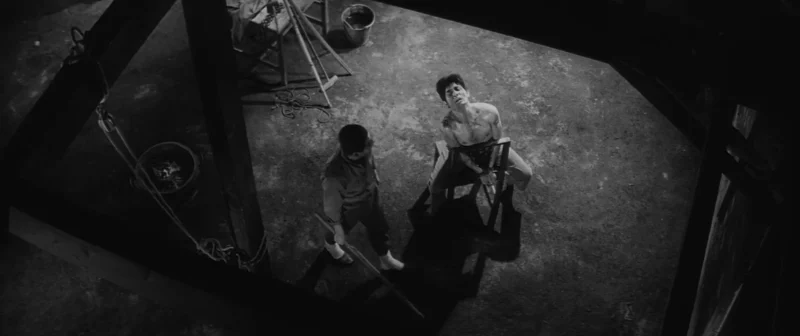
Why is The Human Condition I: No Greater Love such a famous film?
The Human Condition I: No Greater Love ranks as one of the most staggering achievements of Japanese cinema, not only due to its unprecedented exploration of war’s brutalities but also due to its profound examination of human resilience and dignity amid extreme conditions. Its reputation and influence have endured over time, primarily for three main reasons: its meticulous storytelling, universal themes, and daring critique of war and authoritarianism.
The first aspect that solidifies the film’s status in the pantheon of Japanese cinema is its storytelling. Kobayashi’s sprawling trilogy epic, clocking in at nearly ten hours over the full trilogy, is a study in narrative craftsmanship. It takes viewers on an emotional journey through Kaji’s trials and tribulations, resulting in a deeply immersive and moving cinematic experience.
Next, the universal themes explored in The Human Condition I: No Greater Love have given the film an enduring relevance. Its exploration of war’s inhumanity, the resilience of the human spirit, and the struggle for dignity and justice in a system designed to suppress them resonates deeply with audiences across different cultures and historical contexts. These themes remain as pertinent today as they were during the film’s release in the late 1950s.
Finally, the film’s fearless critique of war and authoritarianism is a key factor in its lasting impact. At a time when Japanese society was grappling with the legacies of World War II and the implications of Japan’s wartime mentality, The Human Condition I: No Greater Love served as a bold and necessary critique of militarism and oppression. This courageous stance, combined with the film’s empathetic portrayal of its characters, has garnered it lasting respect and admiration.
If you want more insight into why this film has earned a legendary status, then check out director Masahiro Shinoda’s thoughts, as well as Masaki Kobayashi’s interview with the Directors Guild of Japan. Also, be sure to read the Criterion Collection’s fantastic essay.
Now it’s your turn
Have more unanswered questions about The Human Condition I: No Greater Love? Are there themes or motifs we missed? Is there more to explain about the ending? Please post your questions and thoughts in the comments section! We’ll do our best to address every one of them. If we like what you have to say, you could become part of our movie guide!

